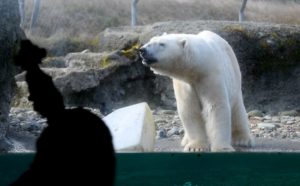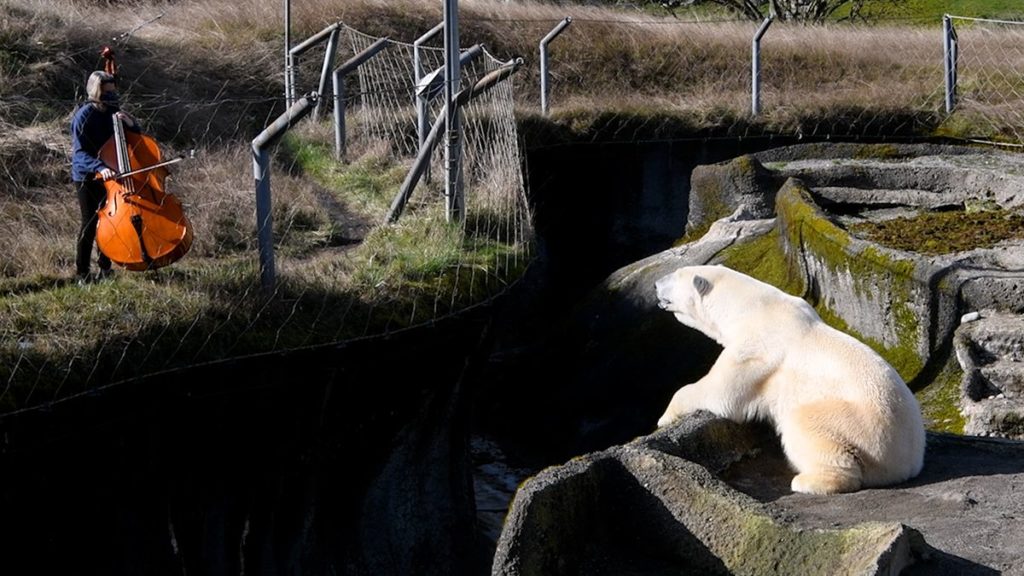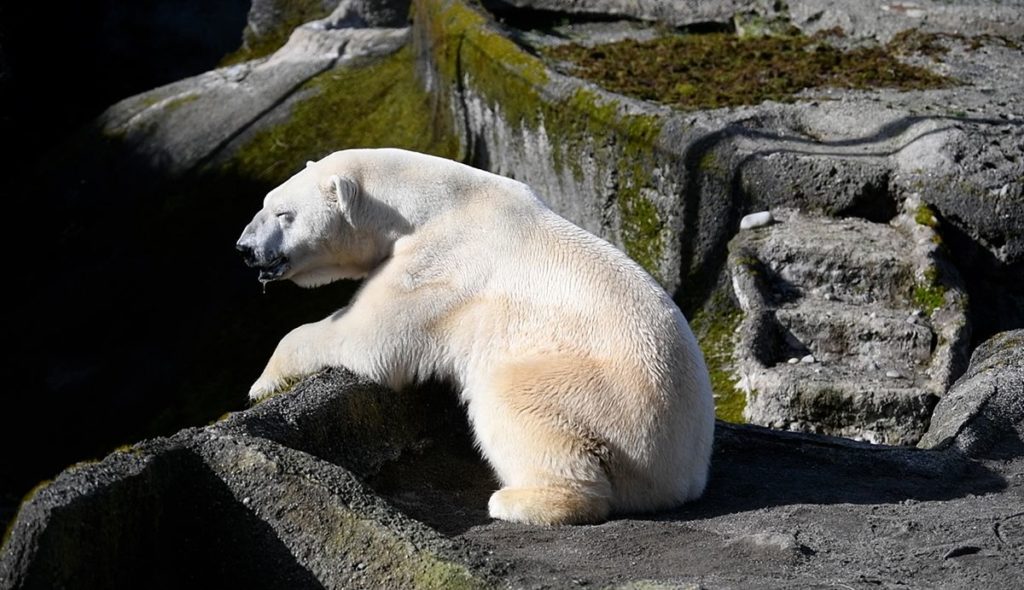It wasn’t your average concert situation.
Fingers chilling in the February breeze, I stood with my double bass poised on the grassy edge of a deep moat. My endpin and boots were planted in winter mud. Somewhere nearby, a bird sang.
I drew my bow across the strings, beginning a low ripple and expanding out to a hopeful chord with deep bass underneath – and my audience of one raised his huge snowy-white head and gazed straight into my eyes. Then he let out a long, breathy “whoosh,” and I answered with an upbow full of air straight off the tundra.
I was playing bass for Blizzard the polar bear, in a performance at least one of us will never forget.
Can you hear me, Blizzard?
The whole thing began a little anticlimactically. Having previously played music with the walruses at Point Defiance Zoo & Aquarium where I work, I had organized with marine mammal curator Malia Somerville to give some musical enrichment to Blizzard. We agreed I’d play to him from the indoor space where Zoo guests watch our polar bear diving in the pool or lounging on land. For one thing, the space had an electrical outlet where I could plug in – I compose music in the moment by layering harmonies with a pedal looper fed through a small speaker, then improvising melodies on top.
But Blizzard makes his own choices during the day, and none of us quite knew where he’d be at the time – or whether he’d even hear my low-pitched low volume through the glass and water. At 25, he’s a senior bear, and sometimes even prefers to stay inside.

So I set up and began playing. Out of the corner of my eye I could see keeper Mike Messersmith on the grassy slope just beyond the habitat’s outer fence, throwing some morning treats for Blizzard, who was apparently behind the rocks. I kept playing, a stormy piece full of fierce chords pulsing across all four strings and low, heavy notes echoing, I imagined, the deliberate power of this Arctic predator.
Still no Blizzard. Moving along the window, I suddenly caught sight of him arching his nose up to sniff the morning air and plunging his face into the pool. He didn’t seem to notice me. Then he ambled up onto a high rock and lay down, clearly soaking up the sunshine after what had been a snowy weekend.
Music for storms, ice and sunshine
As I watched this massive animal taking such pleasure in a sunny nap, I switched tunes. The night before I’d composed a sorrowful lament about melting ice, filled with lonely high harmonics and desperately pacing lower notes, a musical expression of how polar bears in the wild must travel further and further to find food as global warming melts their ice.
But seeing this peaceful polar bear, I changed my mind. Instead, I started playing a piece that flowed happily between two chords in a hopeful, major key. It’s called “Ripple” – and I had the perfect accompaniment in the bubbling, gurgling water of Blizzard’s pool as it passed endlessly through the filter.
But Blizzard paid no attention. Not a lot is known about polar bear hearing: Studies had been done recently on female bears in San Diego Zoo and Sea World San Diego, confirming they can hear in air from around 100Hz to at least 32kHz. Though solitary, polar bears use vocalization for communication when together, especially mothers and cubs. Finding out more about their hearing is crucial to understanding how human noise (like Arctic ships and drilling) impacts their survival as a species.
Blizzard, though, is a male, and I was not only 20 feet away through thick glass but playing at a much lower frequency – a double bass ranges from 40Hz on the lowest string to around 300Hz on the topmost harmonics.
I needed to try something else. So when Somerville agreed to let me go behind the scenes on the grassy, open slope where Mike Messersmith had just been, I jumped at the chance.
Concert for One
Holding my 25-pound instrument before me, I climbed carefully up the wet slope and planted my bass just across the deep moat from Blizzard’s sun-rock. No looping pedal this time: just myself, my bass and a 940-pound polar bear.

I drew the bow across the strings and Blizzard’s head lifted. He opened his dark eyes and stared intently at me. I kept going with the opening of “Ripple,” bright and surprisingly resonant in the open air. Blizzard got to his feet, interested, and stretched his massive head as far forward as he could. We stayed in this tableau for a few minutes, human making music and polar bear listening, connected across an eight-foot interspecies gap by a thread of silvery sound.
Then the astonishing happened. Opening those powerful jaws, which could crush me in an instant, Blizzard let out a long, whooshing sigh. I’d heard him “chuff” before, his usual sound when interacting with keepers, but this was different. It was as if he was trying to make the same kind of long, exhaling sound that I was making through my bass.
Entranced, I played a long whooshy low A back to him, then kept on with the tune. As I improvised, alternating long melody notes with pacing, plucking pizzicato and ethereal upper notes, Blizzard played along. He climbed swiftly down from the rock and stood up to get a closer look (or sniff), standing his full 10 feet on hind legs and never breaking his gaze.
Deep communication
I’ll admit it – at that point, a little part of my brain that wasn’t involved with the music suddenly realized that here was a wild polar bear with drooling jaws and four-inch canines standing just feet away from me, albeit on the other side of a safety fence. But his sheer power was matched by the incredible power of this musical connection between us: a hyper-focused, non-verbal communication of sound and listening that I have never experienced with any human audience.
Finally, Blizzard climbed back up onto the rock and, after one last, lingering glance into my eyes, laid down his head. I wound the piece down, softer and softer, and finally he closed his eyes.

Carrying my bass carefully back down the slope, I asked Somerville what she thought of Blizzard’s reaction. She confirmed that the long “whoosh” was different from his usual chuffs, and agreed it had been a uniquely enriching experience for him.
“That was definitely his ‘I’m curious’ reaction,” she said. “He was clearly very interested: seeing, hearing and smelling. I’m glad we could give him this experience.”
For me, the gratitude went the other way. I have no idea what Blizzard really felt or thought about my music – but to have communicated so intensely with a member of this incredible, endangered species was an experience that I would hold deeply, forever.
Rosemary Ponnekanti works in the marketing department at Point Defiance Zoo & Aquarium and Northwest Trek Wildlife Park. She is also a classically-trained musician. This isn’t her first concert for animals, check out her stories about playing bass for walruses and wolves.